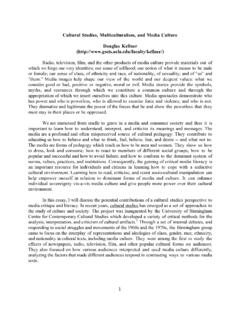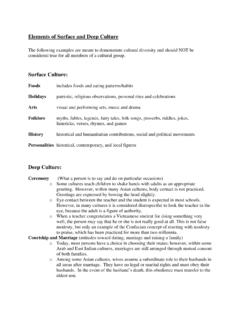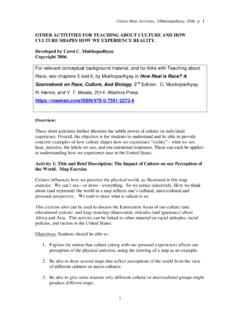Transcription of Mass Culture, Popular Culture and Cultural Identity
1 UNESCO EOLSSSAMPLE CHAPTERSCULTURE, CIVILIZATION AND HUMAN SOCIETY Vol. I Mass Culture , Popular Culture and Cultural Identity - Peter Horn Encyclopedia of Life Support Systems (EOLSS) MASS Culture , Popular Culture AND Cultural Identity Peter Horn University of Cape Town, South Africa Keywords: Anarchy, anthropology, coevalness, common heritage of humankind, Cultural competence, Culture as resource, decadence and degeneration, discourse practices, elites, encounter between cultures, fossilization, inheritance, modernity, music, myths, natural catastrophes, oral tradition, peasant vs. industrial, prehistory, preliterate vs. literate, primitive" societies, religious persecution, rites, nationalist and fundamentalist revivals, rural vs. urban, traditional vs. modern, tribal vs. feudal Contents 1. Traditional Folk Culture , Popular Culture and commercial mass Culture 2. Globalization and commercial mass Culture The commercial Culture of the metropolis Appropriations of traditional Culture The "exotic" within global Culture The marginal existence and the demise of traditional cultures 3.
2 Identities within a global commercial mass Culture Religions, rites and local traditions Sport Consumer goods Pop music TV, Talk shows, Soap operas, films Societies, communities, hobbies 4. Identities against a global commercial mass Culture Nationalisms, racisms, ethnicity Countercultures, subcultures and antisocial identities Glossary Bibliography Biographical Sketch Summary Contemporary Popular and mass Culture has to be differentiated from traditional folk Culture . Popular and mass Culture by definition has been denigrated as an "impoverished". While manipulation is no doubt a key feature of 'mass Culture ' one should not overlook that those who are supposed to be manipulated often find very creative ways of using the material offered by 'mass Culture '. Just as "folk" Culture is not as static as some previous superficial accounts might have suggested, 'mass Culture ' too, is constantly shifting and changing.
3 Many Cultural critics have maintained that on the global plane there is an attempt to create a uniform thinking, a One-Idea-system. When talking about a commercial Culture , one needs to remember, that while this Culture is no doubt the dominant Culture of today, nevertheless it is not equally accessible to all. Therefore, traditional Culture is seen by some as a means to shape their own Identity and UNESCO EOLSSSAMPLE CHAPTERSCULTURE, CIVILIZATION AND HUMAN SOCIETY Vol. I Mass Culture , Popular Culture and Cultural Identity - Peter Horn Encyclopedia of Life Support Systems (EOLSS) to resist the pull of a global Culture that more and more denies such local identities. The Cultural elite, which is marginalized by the Culture industry of the metropolis is therefore often outspoken in the condemnation of global Culture and calls for a return to old national, continental ( African , Latin-American , European etc.) and religious indigenous cultures.
4 Sport, Consumer goods, Pop music, TV, Talk shows, Soap operas, films can be seen in various way of providing a kind of Cultural Identity to those who are denied one otherwise. The flowering of Cultural freedom, the freedom of diversity, is a feat ever more difficult for poor people and weak countries to achieve, condemned as they are to imitating the lifestyle imposed everywhere nowadays as the only possible way of life. 1. Traditional Folk Culture , Popular Culture and commercial mass Culture Culture has always been a means to create perceived difference on the basis of inclusion and exclusion: even hunter and gatherer societies which have few signs of social difference have institutions like the men's house (which excludes women and non-initiates). The more complex the social structure of a society the greater the need to define oneself culturally as belonging to various hierarchically structured groups within society.
5 Serious or high Culture against mass or Popular Culture merely translates these differences into modern societies that, while ostensibly democratic and egalitarian, nevertheless are highly hierarchically structured. Listening to certain forms of music or expressing a preference for certain films still identifies one as a member of the Cultural elite, the political and economic elite, the rising or descending part of the middle classes , or the working class. Bourdieu has identified such identification marks in French society in every sphere of Culture , from the way we eat to the way we furnish our houses and flats, to the sports activities in which we take part or which we attend as spectators. It is not sufficient to define " Popular " as "known by the people, and applauded by them". Contemporary Popular and mass Culture has to be differentiated from traditional folk Culture . Traditional Culture survives in relatively few pockets in societies that have not been touched more than superficially by global mass Culture , in a perverted form as tourist attraction, and, in a secondary form, as a conscious attempt to resist the attractions of mass Culture .
6 Such secondary folk cultures are often regenerated after they had all but succumbed to invaders or to global mass Culture as a conscious effort to regain some form of Cultural Identity . Examples of such "rebirths" are the recovery of the Greek language and Culture after the wars against the Turks in the early nineteenth century, the recovery of the Irish language with its concomitant Cultural practices after the independence of Ireland from Britain. Currently there are attempts by the Maoris in New Zealand, the Aborigines in Australia and many African cultures to "rebirth" their cultures destroyed by colonialism. Related to these attempts are so-called religious or nationalist fundamentalisms, such as the Muslim and Hindu fundamentalisms. Such revivals often use the desire for a rediscovery of national or religious Identity and roots as a political rallying cry. While folk traditions can gain Cultural respectability - the rediscovery of folk music by Eastern European "classical" composers in the nineteenth century in the context of Pan-Slavonic nationalisms, or the rediscovery of folk songs and fairy tales during UNESCO EOLSSSAMPLE CHAPTERSCULTURE, CIVILIZATION AND HUMAN SOCIETY Vol.
7 I Mass Culture , Popular Culture and Cultural Identity - Peter Horn Encyclopedia of Life Support Systems (EOLSS) German Romanticism - Popular and mass Culture by definition has been denigrated as an "impoverished" and "primitive" Culture , not worthy of any attention by Cultural historians and theoreticians until recently. The typical 'elite' reaction to mass Culture is still very much in evidence. Dismissal and contempt are still key features in a landscape where members of the intellectual elite find themselves and their concept of 'high Culture ' more and more marginalized. In contrast, the Centre for Contemporary Cultural Studies at the University of Birmingham in the 1970s set about the discovery of Popular cultures and youth subcultures. They stressed the inventiveness and subtlety of Popular Culture . There was also a Neo-Marxist research into the oppositional quality of Popular Cultural forms and their subversive appropriation of elements of the bourgeois commodified Culture , in striking contrast to the very reserved and often hostile stance of official Cultural policy towards many forms of Western Popular Culture in the communist countries.
8 However, the analysis of mass Culture in the sixties, mainly by neo-Marxist critics, was at once drawn to what was perceived Popular , and highly critical towards what was perceived as manipulative and disempowering in a predominantly American film and pop music Culture . Both these attitudes have become even more pronounced as mainly American Culture began to dominate the global scene. The question that they attempted to answer was: To what extent is our 'mass Culture ' one of manipulation and shallowness, or one of choice and contentment? While manipulation is no doubt a key feature of 'mass Culture ' one should not overlook that those who are supposed to be manipulated often find very creative ways of using the material offered by 'mass Culture ' in a way not intended by those who may want to manipulate them. As Bourdieu has shown, building on our knowledge of these social phenomena, it seems both possible and necessary to determine the use to which they are put by groups or individuals.
9 For example, the analysis of the images broadcast by television and of the time spent watching television behavior should be complemented by a study of what the user "does" during this time and with these images. The same goes for the use of urban space, the products purchased in the supermarket, the stories and legends distributed by the newspapers, and so on. Without wanting to endorse the neo-liberal argument that the inalienable right to choose is always being exercised, or that any satisfaction we derive from Popular Culture is always complete and without its own contradictions, one should not overlook the fact that the consumers are not only passive dupes of the market. That does not mean that every consumer has the same freedom to deal with the objects offered him by commercial media. The procedures allowing the reuse of products are linked together in a kind of obligatory language, and their functioning is related to social situations and power relationships.
10 Confronted by images on television, the immigrant worker does not have the same critical or creative elbowroom as the average citizen. On the same terrain, his inferior access to information, financial means, and compensations of all kinds elicits an increased deviousness, fantasy, or laughter. Similar strategic deployments, when acting on different relationships of force, do not produce identical effects. Hence the necessity of differentiating both the "actions" or "engagements" (in the military sense) that the system of products effects within the consumer grid, and the various kinds of room to maneuver left for consumers by the situations in which they exercise their "art." UNESCO EOLSSSAMPLE CHAPTERSCULTURE, CIVILIZATION AND HUMAN SOCIETY Vol. I Mass Culture , Popular Culture and Cultural Identity - Peter Horn Encyclopedia of Life Support Systems (EOLSS) One should also not overlook the fact that the consumers of mass Culture often manage to include in the commercial channels Cultural artifacts which go against everything commercial Culture would want to advertise, because if the merchants of 'mass Culture ' want to make a profit they have to sell even those products which they probably loathe.
















